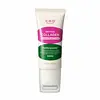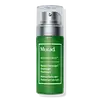What's inside
What's inside
 Key Ingredients
Key Ingredients

 Benefits
Benefits

 Concerns
Concerns

 Ingredients Side-by-side
Ingredients Side-by-side

Water
Skin ConditioningGlycerin
HumectantCaprylic/Capric Triglyceride
MaskingButylene Glycol
HumectantPentylene Glycol
Skin ConditioningNiacinamide
Smoothing1,2-Hexanediol
Skin ConditioningCetearyl Olivate
Hydrogenated Polyisobutene
EmollientSorbitan Olivate
EmulsifyingPolyglyceryl-3 Methylglucose Distearate
EmulsifyingVinyldimethicone
Diisostearyl Malate
EmollientGlyceryl Stearate
EmollientCaprylyl Methicone
Skin ConditioningErythritol
HumectantCetearyl Alcohol
EmollientGlucose
HumectantChlorella Vulgaris Extract
Skin ConditioningCarbomer
Emulsion StabilisingAmmonium Acryloyldimethyltaurate/Vp Copolymer
Fructooligosaccharides
HumectantFructose
HumectantCitrus Aurantium Bergamia Fruit Oil
MaskingMelia Azadirachta Flower Extract
Skin ConditioningOcimum Sanctum Leaf Extract
Skin ConditioningPalmitic Acid
EmollientEthylhexylglycerin
Skin ConditioningDipotassium Glycyrrhizate
HumectantStearic Acid
CleansingAdenosine
Skin ConditioningMelia Azadirachta Leaf Extract
Skin ConditioningLavandula Angustifolia Oil
MaskingHydrogenated Lecithin
EmulsifyingSodium Phytate
Retinal
Skin ConditioningCurcuma Longa Root Extract
MaskingCorallina Officinalis Extract
Skin ConditioningSalvia Sclarea Oil
MaskingHydrolyzed Collagen
EmollientCeramide NP
Skin ConditioningTheobroma Cacao Seed Extract
AntioxidantDextrin
AbsorbentGlycine
BufferingSerine
MaskingGlutamic Acid
HumectantTromethamine
BufferingDipropylene Glycol
HumectantCynanchum Atratum Extract
Skin ConditioningAspartic Acid
MaskingLeucine
Skin ConditioningAlanine
MaskingLysine
Skin ConditioningArginine
MaskingTyrosine
MaskingPhenylalanine
MaskingProline
Skin ConditioningValine
MaskingThreonine
Isoleucine
Skin ConditioningHistidine
HumectantMethionine
Skin ConditioningCysteine
AntioxidantHyaluronic Acid
HumectantAlthaea Rosea Flower Extract
Skin ConditioningTocopherol
AntioxidantCaprylyl/Capryl Glucoside
CleansingHexapeptide-2
BleachingHydrolyzed Elastin
EmollientBiotin
AntiseborrhoeicLimonene
PerfumingLinalool
PerfumingWater, Glycerin, Caprylic/Capric Triglyceride, Butylene Glycol, Pentylene Glycol, Niacinamide, 1,2-Hexanediol, Cetearyl Olivate, Hydrogenated Polyisobutene, Sorbitan Olivate, Polyglyceryl-3 Methylglucose Distearate, Vinyldimethicone, Diisostearyl Malate, Glyceryl Stearate, Caprylyl Methicone, Erythritol, Cetearyl Alcohol, Glucose, Chlorella Vulgaris Extract, Carbomer, Ammonium Acryloyldimethyltaurate/Vp Copolymer, Fructooligosaccharides, Fructose, Citrus Aurantium Bergamia Fruit Oil, Melia Azadirachta Flower Extract, Ocimum Sanctum Leaf Extract, Palmitic Acid, Ethylhexylglycerin, Dipotassium Glycyrrhizate, Stearic Acid, Adenosine, Melia Azadirachta Leaf Extract, Lavandula Angustifolia Oil, Hydrogenated Lecithin, Sodium Phytate, Retinal, Curcuma Longa Root Extract, Corallina Officinalis Extract, Salvia Sclarea Oil, Hydrolyzed Collagen, Ceramide NP, Theobroma Cacao Seed Extract, Dextrin, Glycine, Serine, Glutamic Acid, Tromethamine, Dipropylene Glycol, Cynanchum Atratum Extract, Aspartic Acid, Leucine, Alanine, Lysine, Arginine, Tyrosine, Phenylalanine, Proline, Valine, Threonine, Isoleucine, Histidine, Methionine, Cysteine, Hyaluronic Acid, Althaea Rosea Flower Extract, Tocopherol, Caprylyl/Capryl Glucoside, Hexapeptide-2, Hydrolyzed Elastin, Biotin, Limonene, Linalool
Water
Skin ConditioningDiisostearyl Malate
EmollientPentylene Glycol
Skin ConditioningPolyglyceryl-3 Methylglucose Distearate
EmulsifyingZea Mays Kernel Extract
Squalane
EmollientPropanediol
SolventHydroxyethyl Acrylate/Sodium Acryloyldimethyl Taurate Copolymer
Emulsion StabilisingGlycerin
HumectantCetearyl Alcohol
EmollientGlyceryl Ricinoleate
EmollientAvena Sativa Kernel Extract
AbrasiveButyrospermum Parkii Butter
Skin ConditioningRetinal
Skin ConditioningUrea
BufferingYeast Amino Acids
HumectantTrehalose
HumectantInositol
HumectantTaurine
BufferingBetaine
HumectantAnigozanthos Flavidus Extract
Skin ConditioningPhosphatidylcholine
EmulsifyingOlea Europaea Leaf Extract
PerfumingMannitol
HumectantEthylhexylglycerin
Skin ConditioningDimethyl Isosorbide
SolventGlyceryl Stearate
EmollientSodium Stearoyl Glutamate
CleansingCetyl Alcohol
EmollientHectorite
AbsorbentXanthan Gum
EmulsifyingSodium Chloride
MaskingPolysorbate 60
EmulsifyingSorbitan Isostearate
EmulsifyingLeuconostoc/Radish Root Ferment Filtrate
AntimicrobialTetrasodium Glutamate Diacetate
Citric Acid
BufferingSodium Benzoate
MaskingChlorphenesin
AntimicrobialPotassium Sorbate
PreservativeCitronellol
PerfumingAlpha-Isomethyl Ionone
PerfumingParfum
MaskingWater, Diisostearyl Malate, Pentylene Glycol, Polyglyceryl-3 Methylglucose Distearate, Zea Mays Kernel Extract, Squalane, Propanediol, Hydroxyethyl Acrylate/Sodium Acryloyldimethyl Taurate Copolymer, Glycerin, Cetearyl Alcohol, Glyceryl Ricinoleate, Avena Sativa Kernel Extract, Butyrospermum Parkii Butter, Retinal, Urea, Yeast Amino Acids, Trehalose, Inositol, Taurine, Betaine, Anigozanthos Flavidus Extract, Phosphatidylcholine, Olea Europaea Leaf Extract, Mannitol, Ethylhexylglycerin, Dimethyl Isosorbide, Glyceryl Stearate, Sodium Stearoyl Glutamate, Cetyl Alcohol, Hectorite, Xanthan Gum, Sodium Chloride, Polysorbate 60, Sorbitan Isostearate, Leuconostoc/Radish Root Ferment Filtrate, Tetrasodium Glutamate Diacetate, Citric Acid, Sodium Benzoate, Chlorphenesin, Potassium Sorbate, Citronellol, Alpha-Isomethyl Ionone, Parfum
 Reviews
Reviews

Ingredients Explained
These ingredients are found in both products.
Ingredients higher up in an ingredient list are typically present in a larger amount.
Cetearyl alcohol is a mixture of two fatty alcohols: cetyl alcohol and stearyl alcohol. It is mainly used as an emulsifier. Emulsifiers help prevent the separation of oils and products. Due to its composition, it can also be used to thicken a product or help create foam.
Cetearyl alcohol is an emollient. Emollients help soothe and hydrate the skin by trapping moisture.
Studies show Cetearyl alcohol is non-toxic and non-irritating. The FDA allows products labeled "alcohol-free" to have fatty alcohols.
This ingredient is usually derived from plant oils such as palm, vegetable, or coconut oils. There is debate on whether this ingredient will cause acne.
Due to the fatty acid base, this ingredient may not be Malassezia folliculitis safe.
Learn more about Cetearyl AlcoholDiisostearyl Malate is an emollient and most often used in lip products. It comes from isostearyl alcohol, a fatty acid, and malic acid, an AHA.
As an emollient, Diisostearyl Malate helps create a thin film on your skin to trap moisture in. This helps keep your skin soft and smooth.
Ethylhexylglycerin (we can't pronounce this either) is commonly used as a preservative and skin softener. It is derived from glyceryl.
You might see Ethylhexylglycerin often paired with other preservatives such as phenoxyethanol. Ethylhexylglycerin has been found to increase the effectiveness of these other preservatives.
Glycerin is already naturally found in your skin. It helps moisturize and protect your skin.
A study from 2016 found glycerin to be more effective as a humectant than AHAs and hyaluronic acid.
As a humectant, it helps the skin stay hydrated by pulling moisture to your skin. The low molecular weight of glycerin allows it to pull moisture into the deeper layers of your skin.
Hydrated skin improves your skin barrier; Your skin barrier helps protect against irritants and bacteria.
Glycerin has also been found to have antimicrobial and antiviral properties. Due to these properties, glycerin is often used in wound and burn treatments.
In cosmetics, glycerin is usually derived from plants such as soybean or palm. However, it can also be sourced from animals, such as tallow or animal fat.
This ingredient is organic, colorless, odorless, and non-toxic.
Glycerin is the name for this ingredient in American English. British English uses Glycerol/Glycerine.
Learn more about GlycerinGlyceryl Stearate is a mix of glycerin and stearic acid.
It is used to stabilize the mixing of water and oil ingredients. By preventing these ingredients from separating, it can help elongate shelf life. It can also help thicken the product's texture.
As an emollient, it helps soften skin and supports barrier-replenishing ingredients.
In cosmetics, Glyceryl Stearate is often made from vegetable oils or synthetically produced.
This ingredient may not be fungal-acne safe
Fun fact: The human body also creates Glyceryl Stearate naturally.
Learn more about Glyceryl StearatePentylene glycol is typically used within a product to thicken it. It also adds a smooth, soft, and moisturizing feel to the product. It is naturally found in plants such as sugar beets.
The hydrophilic trait of Pentylene Glycol makes it a humectant. As a humectant, Pentylene Glycol helps draw moisture from the air to your skin. This can help keep your skin hydrated.
This property also makes Pentylene Glycol a great texture enhancer. It can also help thicken or stabilize a product.
Pentylene Glycol also acts as a mild preservative and helps to keep a product microbe-free.
Some people may experience mild eye and skin irritation from Pentylene Glycol. We always recommend speaking with a professional about using this ingredient in your routine.
Pentylene Glycol has a low molecular weight and is part of the 1,2-glycol family.
Learn more about Pentylene GlycolPolyglyceryl-3 Methylglucose Distearate is created from the diester of stearic acid and the condensation product of methylglucose and Polyglycerin-3.
As an emulsifier, it is used to bind ingredients together. Many ingredients, such as oils and water, separate naturally. Emulsifiers prevent them from separating to ensure even consistency in texture.
One of the manufacturer for this ingredient states it is vegetable-based. It is also claimed to be stable at both high and low temperatures.
This ingredient may not be safe for fungal acne. We recommend speaking with a professional if you have any concerns.
Learn more about Polyglyceryl-3 Methylglucose DistearateRetinal is a form of retinoid. Retinoids are the gold-standard class of anti-aging ingredients.
Retinal has many benefits as other retinoids: improve skin texture, reduce large pores, reduce the effects of aging, reduce the visibility of dark spots, heal scars, and fight acne.
Studies show retinal may work at a faster rate than retinol due to its structure.
All retinoids have to be converted into retinoic acid before starting to work. Some retinoids take several steps of conversion before binding. Retinal is only one step away, making it more potent.
Like other retinoids, retinal may be irritating. It is best to ease into using this ingredient frequently.
Using the 'ramp up' method, start by using retinol once a week. This gives your skin time to adjust and decrease irritation. Once you feel ready, you can slowly increase the frequency of retinol use.
Using retinoids will increase sun-sensitivity in the first few weeks of use. Though studies show retinoids increase your skin's natural SPF with continuous use, it is best to always wear sunscreen and sun-protection.
Learn more about RetinalWater. It's the most common cosmetic ingredient of all. You'll usually see it at the top of ingredient lists, meaning that it makes up the largest part of the product.
So why is it so popular? Water most often acts as a solvent - this means that it helps dissolve other ingredients into the formulation.
You'll also recognize water as that liquid we all need to stay alive. If you see this, drink a glass of water. Stay hydrated!
Learn more about Water